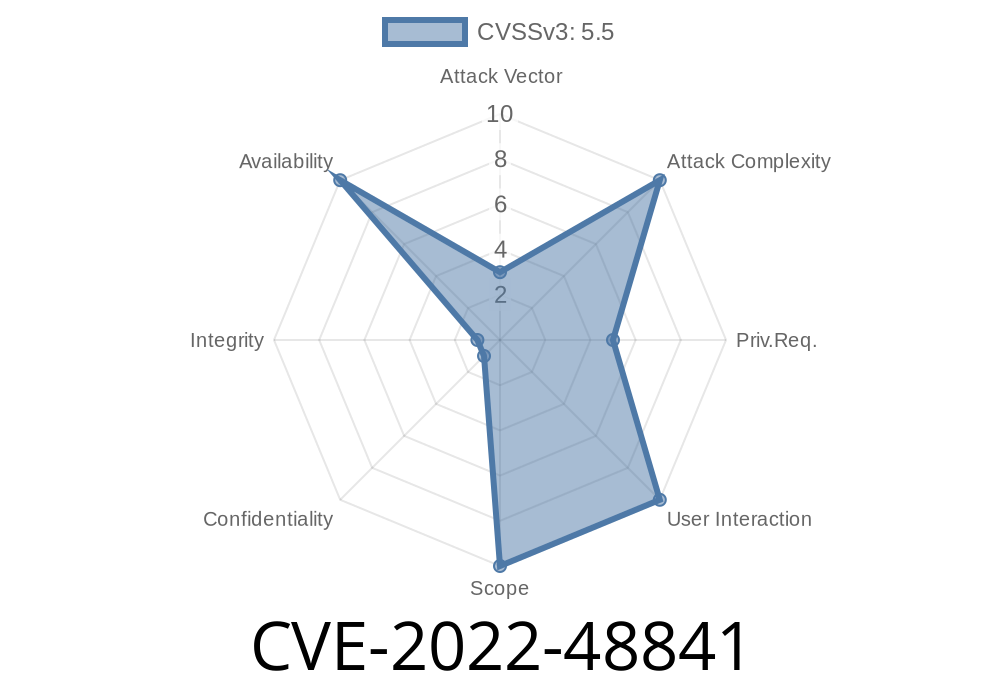---
The Linux kernel powers everything from your Android phone to the majority of servers that keep the internet ticking. As with any software, flaws sometimes creep in. Today, we’re going to do a deep dive into CVE-2022-48841, a real-world vulnerability found in the Linux kernel’s network driver — specifically, in the ICE (Intel Ethernet Controller) code.
This is one of those “simple-but-deadly” NULL pointer dereference bugs, and while it may sound technical, I’ll break down exactly what happened, show the problematic code, how the fix works, and even discuss exploitability.
What is CVE-2022-48841?
*CVE-2022-48841* is a vulnerability in the Linux kernel network driver for Intel 700 series Ethernet cards, notably in the routine for updating transmit (Tx) ring statistics in the ICE driver:
ice_update_vsi_tx_ring_stats()
Summary:
A missing NULL check on a pointer can cause the kernel to access memory at address zero (NULL pointer dereference). This triggers a kernel panic, crashing the affected machine.
Where Did It Go Wrong? (The Vulnerable Code)
The bug lived in a part of the driver that updates stats for each “Tx ring.” Think of Tx rings as internal structures used by the network card to move data.
Here’s a simplified version of the problematic code (before the fix)
for (i = ; i < vsi->num_txq; i++) {
struct ice_ring *ring = vsi->tx_rings[i];
if (ring) {
bytes += u64_stats_read(&ring->syncp, &ring->stats.bytes);
packets += u64_stats_read(&ring->syncp, &ring->stats.packets);
}
vsi->tx_stats.bytes = bytes;
vsi->tx_stats.packets = packets;
}
What’s wrong?
If ring is NULL, the code skips adding stats. But after the if (ring) check, it blindly writes to vsi->tx_stats.*, which is fine.
*However*, in the real code, there were accesses to fields through the ring pointer outside the if (ring) block, risking a NULL pointer dereference.
The Fix: Guard Your Pointers!
The fix is beautifully simple. From the Linux kernel commit:
for (i = ; i < vsi->num_txq; i++) {
- struct ice_ring *ring = vsi->tx_rings[i];
- if (ring) {
- bytes += u64_stats_read(&ring->syncp, &ring->stats.bytes);
- packets += u64_stats_read(&ring->syncp, &ring->stats.packets);
- }
- vsi->tx_stats.bytes = bytes;
- vsi->tx_stats.packets = packets;
+ struct ice_ring *ring = vsi->tx_rings[i];
+ if (!ring)
+ continue;
+ bytes += u64_stats_read(&ring->syncp, &ring->stats.bytes);
+ packets += u64_stats_read(&ring->syncp, &ring->stats.packets);
+ vsi->tx_stats.bytes = bytes;
+ vsi->tx_stats.packets = packets;
}
Or, even simpler in modern code, the tricky code beyond the if (ring) check was moved inside, so nothing is accessed if ring is NULL — problem solved.
Links to References
- Linux kernel patch and changelog
- CVE page on NVD
- Kernel bug tracking discussion
Exploiting CVE-2022-48841
Can this bug be exploited?
Yes, but with limits.
- NULL pointer dereference usually leads to a *denial of service* (system crash/panic).
- It does *not* give an attacker code execution on modern kernels, because the kernel doesn’t allow mapping data at address zero.
- Attack surface: You need the driver (ice) loaded, and you (or some program) needs to trigger the vulnerable code path with a misconfigured or destroyed Tx ring (the details depend on internal developer APIs and/or specific hardware states).
Example Exploit
While a single code snippet won’t pop a shell, a local attacker with enough permission could crash the system by messing with Tx rings to force a NULL ring entry.
Below is a hypothetical scenario
// Pseudo-code: Only possible in-kernel or with privileged access
struct ice_vsi *vsi = ...; // get the right structure
vsi->tx_rings[random_index] = NULL; // null out a tx_ring
ice_update_vsi_tx_ring_stats(vsi); // trigger the crash
On an unpatched kernel, this would try to access fields through the NULL pointer.
If you’re root or have the ability to crash the networking device through privileged IOCTLs or configuration tools, you could knock a machine offline.
Who Is At Risk?
If you are using Linux with Intel 700 series network cards and you haven’t applied updates since late 2022, you *could* be vulnerable — especially on servers with custom setups, or if untrusted code can access network configuration.
How Can You Protect Yourself?
- Update your kernel: Make sure you’re running a version including the fix (Dec 2022 or newer).
Conclusion
CVE-2022-48841 is a great example of how a humble NULL pointer bug in a network driver can bring down a Linux server. While not the most dramatic vulnerability, these bugs *matter* — especially in critical network environments.
Always keep your Linux kernel up-to-date, especially if you use enterprise or large-scale networking gear. And remember: even “simple” bugs in ring buffer management can have real-world impact!
*(This article is for educational purposes. Don’t try to crash production servers!)*
Further reading:
- ICE driver documentation
- Understanding kernel crashes (LWN)
Timeline
Published on: 07/16/2024 13:15:11 UTC
Last modified on: 08/03/2024 15:25:01 UTC
